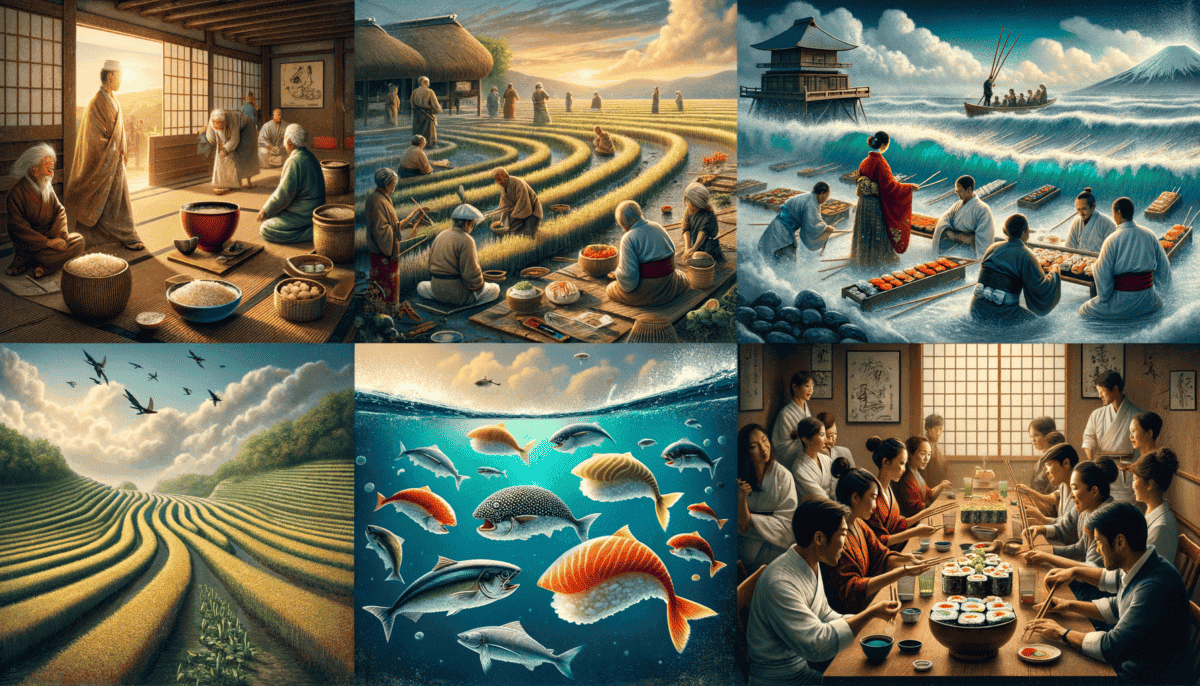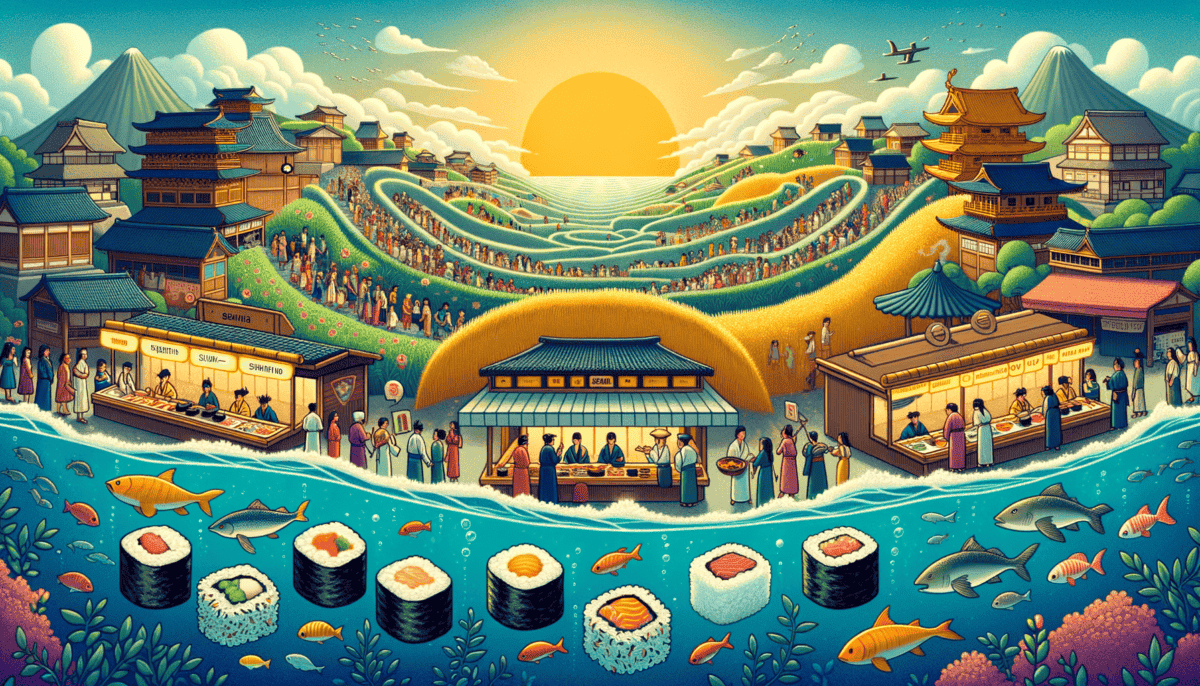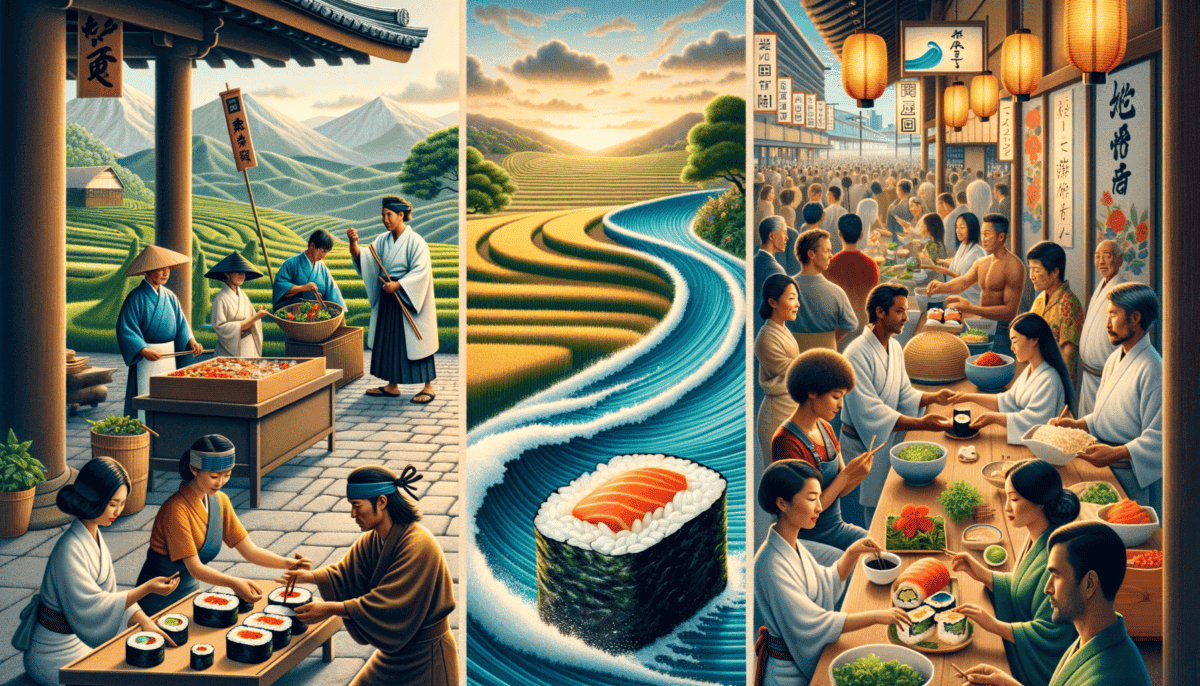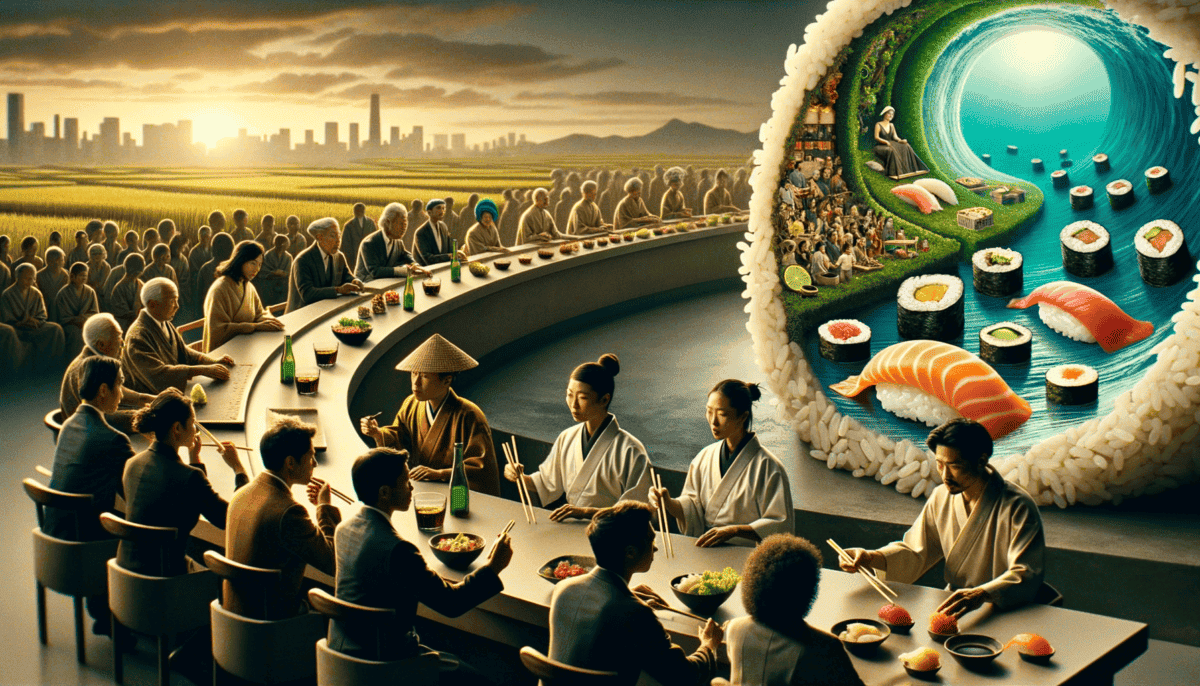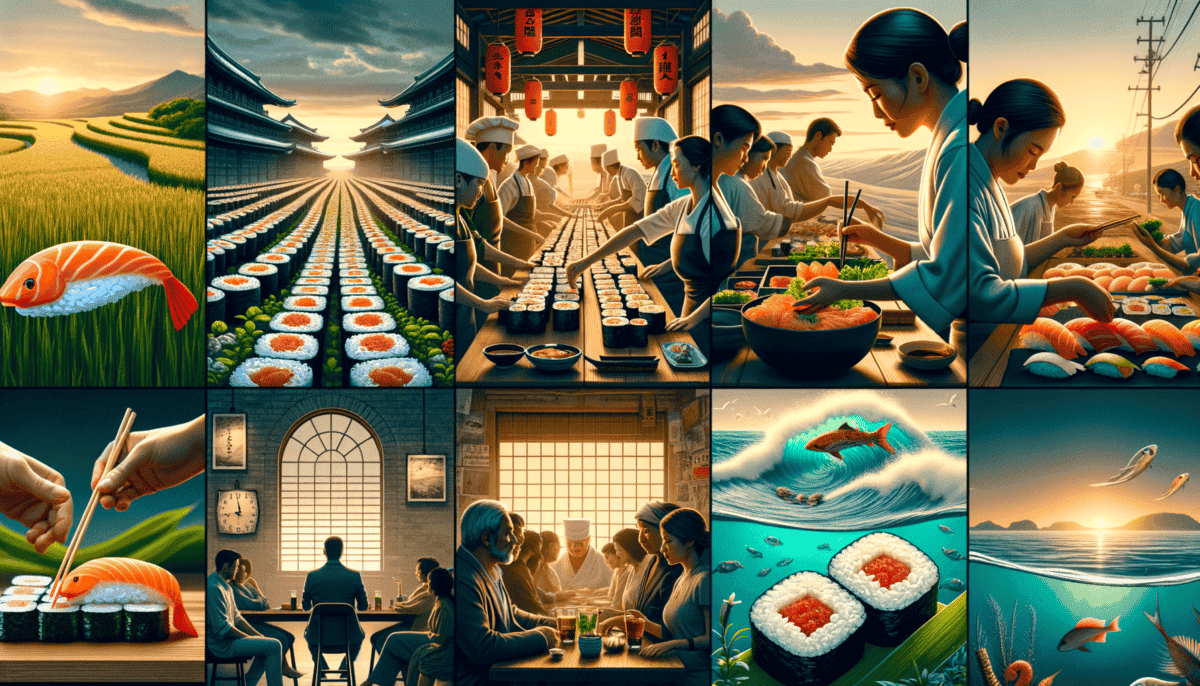Rice, Fish, and Ancient Beginnings
Long, long ago, in a place where rivers met the sea, people found a clever way to keep their fish fresh. This is where our tasty tale of sushi begins!
Little Mei, a fisherman's daughter, watched as her father brought home his daily catch. The sun was setting, painting the sky in beautiful orange and pink colors.
"Papa, why do you put the fish in rice?" Mei asked, her curious eyes following her father's movements.
"Ah, my dear," he smiled, carefully wrapping a fish in rice. "This is how we make our fish last longer. The rice helps keep it good to eat for many days."
The village people had discovered something magical – when they packed fresh fish in rice, a special process called fermentation happened. It was like a natural way of keeping food safe to eat, just like how we use refrigerators today! ❄️
In those early days, people didn't eat the rice – they only used it to wrap the fish. They would throw the rice away and eat just the fish. But something wonderful was about to happen!
One day, while watching the sunset, Mei had an idea. "Papa, what if we ate the rice too? It smells so good after the fish has been in it!"
Her father laughed. "That's silly, Mei! We've never done that before."
But Mei insisted on trying it. To everyone's surprise, the rice tasted amazing with the fish! It had soaked up all the delicious flavors.
“Sometimes the best discoveries happen by accident,” Mei’s father would say years later, telling the story to his grandchildren.
As time passed, more and more people started eating the rice with the fish. They experimented with different types of fish and ways to prepare the rice. It was the beginning of something special that would one day travel all around the world!
The practice spread from village to village, each adding their own special touch. Some added spices to the rice, while others tried different kinds of fish. It was like a delicious game of mixing and matching!
The First Sushi Masters
Soon, certain people became known for their skill in preparing this special dish. They learned exactly how long to let the fish stay in the rice, and which fish tasted best prepared this way.
"One day," Mei told her little brother, "I want to learn all about making the perfect fish and rice dish!"
Her brother giggled. "You just want to play with food!"
"No," Mei said seriously. "I want to create something that makes people happy when they eat it."
And that's exactly what happened – this simple way of keeping fish fresh turned into something that would bring joy to people all over the world. It was just the beginning of a food adventure that would last for hundreds of years!
People started traveling from far away just to taste these special fish and rice creations. They would bring news of different ways to prepare it from other villages and towns.
The story of sushi had begun, but it was far from over. New ideas and ways of making it were just waiting to be discovered. And as we'll see, this was just the first chapter in a very long and tasty journey!
The Edo Period Transformation
The busy streets of Edo (now called Tokyo) buzzed with excitement. It was the 1800s, and the city was growing bigger every day!
Little Taro loved watching the street vendors with their colorful carts. His favorite was old Mr. Hanaya, who made something new and exciting – nigiri sushi!
“Look how fast his hands move!” Taro exclaimed, watching Mr. Hanaya shape rice and top it with fresh fish.
“Want to know a secret?” Mr. Hanaya winked at Taro. “I add a tiny bit of vinegar to the rice. It gives the same tangy taste as the old way, but much faster!”
The streets were full of hungry workers who needed quick lunches. They loved this new “fast food” sushi that they could eat with their hands while standing.
“Fresh fish, fresh rice! Get your sushi here!” the vendors would call out, their voices mixing with the sounds of the busy city.
A New Way of Eating
Taro watched as more and more sushi carts appeared on street corners. Each vendor had their own special way of making sushi:
• Some made their rice extra fluffy
• Others used different kinds of fish
• Some added special sauces
• Many created their own secret recipes
One day, Taro’s mother came home excited. “The sushi vendors are moving into real shops now!” she said. “They’re calling them ‘sushi-ya.'”
These little sushi shops became popular meeting places. People would stand at the counter, chat with friends, and watch the sushi makers work their magic.
“Can you teach me to make sushi?” Taro asked Mr. Hanaya one day.
The old man smiled. “First, you must learn to make perfect rice. Without good rice, there is no good sushi.”
And so began Taro’s lessons. He learned how to:
– Wash the rice just right
– Mix the perfect amount of vinegar
– Shape the rice with gentle hands
The city kept growing, and sushi changed with it. Rich merchants started asking for fancier kinds of fish. Some people wanted their sushi with special toppings.
“Every day brings something new,” Mr. Hanaya told Taro. “That’s what makes sushi so special – it keeps changing while staying true to its heart.”
A City’s Favorite Food
Soon, sushi wasn’t just street food anymore. It became a symbol of Edo’s spirit – quick, creative, and full of life!
Even the samurai started eating at sushi shops. They would sit next to common workers, everyone enjoying the same delicious food.
“Sushi brings people together,” Taro noticed. “Rich or poor, everyone smiles when they eat good sushi.”
As the sun set over Edo each day, the sushi shops glowed with lantern light. The sound of happy customers and the smell of vinegared rice filled the air.
The story of sushi was changing. From a way to preserve food, it had become something new – fast, fresh, and perfect for city life. But this was still just the beginning of sushi’s amazing journey!
Masters of Rice and Fish
Young Kenji stood nervously at the door of Master Yoshida’s sushi shop. Today was his first day as an apprentice!
“Welcome,” Master Yoshida said with a stern face. “Are you ready to begin your journey?”
Kenji nodded eagerly. He thought he would start making sushi right away. But Master Yoshida had other plans.
“First, you will learn to wash rice,” Master Yoshida explained. “For one whole year, this will be your only job.”
Kenji’s eyes went wide. “A whole year just washing rice?”
“The rice is the heart of sushi,” Master Yoshida said softly. “Without perfect rice, there can be no perfect sushi.”
The Long Road to Mastery
Every morning, Kenji arrived before sunrise. His daily tasks were:
- Wash the rice seven times
- Clean the entire kitchen
- Sharpen the knives
- Watch and learn from the master
“Your hands must become one with the rice,” Master Yoshida would say. “Feel how each grain moves in the water.”
After a year of washing rice, Kenji learned to make the vinegar mixture. Then came knife skills. Each new skill took months to master.
More Than Just Cooking
“Sushi is not just food,” Master Yoshida taught. “It is art. It is spirit. It is a way of life.”
Kenji learned that making sushi meant:
– Being clean and neat
– Showing respect to the fish
– Making guests feel special
– Always trying to improve
Master Yoshida shared stories passed down from his teacher, and his teacher’s teacher before him. Each sushi master added their own special knowledge to share with the next generation.
Family Traditions
One day, a young girl visited the shop with her father, another sushi master.
“My daughter will be the fifth generation of sushi makers in our family,” the father said proudly.
Many sushi skills were family secrets, passed down from parent to child. Each family had their own special way of:
– Making rice
– Cutting fish
– Creating special sauces
– Serving customers
The Final Test
After many years, Master Yoshida called Kenji to make sushi for a special customer.
“Remember everything you have learned,” he said. “Show me your spirit in every piece.”
Kenji’s hands moved smoothly, shaping the rice with care. He cut the fish with perfect skill. When he finished, Master Yoshida smiled.
“Now you understand,” he said. “Sushi is not just what we make. It is who we are.” ✨
As Kenji looked at his perfect sushi pieces, he knew his journey was just beginning. There would always be more to learn, more ways to improve, more traditions to carry forward.
When Earth Shakes, Sushi Changes
The ground rumbled and shook in Tokyo. It was September 1, 1923. The Great Kanto Earthquake had arrived!
Master Tanaka grabbed his most precious knife as his sushi shop crumbled. All around him, buildings fell and fires started.
“We must leave Tokyo,” Master Tanaka told his family and apprentices. “But we will carry our sushi knowledge with us.”
Moving to New Places
Many sushi masters left Tokyo after the earthquake. They traveled to different parts of Japan, taking their special skills with them.
“Where will we go?” asked Shin, Master Tanaka’s youngest apprentice.
“To Osaka,” Master Tanaka smiled. “We will start fresh and teach people there about Tokyo-style sushi.”
“When life changes, sushi changes too. That’s how it grows stronger!” – Master Tanaka
New Kinds of Sushi
Something amazing happened when sushi masters moved to new places. They created new kinds of sushi! Here’s what changed:
- Different local fish were used
- New flavors were added
- Special local ingredients joined in
- New ways of serving sushi appeared
In Osaka, Master Tanaka discovered fresh river fish. “Look, Shin!” he said excitedly. “We can make sushi with these too!”
Sharing and Learning
Shin watched as people in Osaka tried Tokyo-style sushi for the first time.
“It’s different from our local food,” they said. “But we like it!”
Master Tanaka learned from Osaka’s cooks too. He discovered new ways to make his sushi even better.
Growing Stronger
Years later, Shin had his own sushi shop in Osaka. He made both Tokyo-style and Osaka-style sushi.
“The earthquake was scary,” he told his apprentices. “But look what happened! Sushi spread across Japan and got even better!” ✨
“Now we know more ways to make sushi than ever before,” Master Tanaka said proudly. “Sometimes good things come from hard times.”
A New Chapter
The earthquake changed sushi forever. But it didn’t break the sushi masters’ spirit. Instead, it helped sushi grow and change in wonderful new ways.
Master Tanaka looked at his busy shop in Osaka. “See, Shin? Sushi is like water. It flows around problems and finds new paths. That’s why it will always survive.”
As customers enjoyed both Tokyo and Osaka styles of sushi, Shin realized that change wasn’t always bad. Sometimes it made things even more special!
When Sushi Found New Friends
After World War II, something amazing happened. Sushi packed its bags and went on a big adventure!
The Big Move
Mr. Yoshida opened a tiny sushi shop in Los Angeles. But he noticed something funny – his American customers weren’t sure about eating raw fish!
“We need to make sushi that everyone will love,” he told his daughter Maya.
“But how?” Maya asked, watching people walk past their shop.
A Magical New Roll
One day, Maya had a brilliant idea! “What if we put the seaweed on the inside and use avocado instead of raw fish?”
“Sometimes making new friends means trying new things!” – Maya
That’s how the California Roll was born! It was like a friendly handshake between Japanese and American food. People loved it!
Sushi’s New Friends
Soon, more people wanted to try sushi. Chefs got creative and made new rolls with:
- Cream cheese
- Cooked fish
- Crunchy tempura
- Fresh vegetables
Sharing is Caring
“Look, Papa!” Maya pointed at their busy restaurant. “Now everyone loves sushi!”
Mr. Yoshida smiled. His little shop had become a place where people from all over came to enjoy Japanese food.
“When we share our food, we share our hearts,” he said, teaching a young American chef how to roll sushi.
Growing Together
More Japanese restaurants opened. People everywhere started learning about chopsticks and saying “Itadakimasu!” before meals.
“Sushi is bringing people together,” Maya noticed. She saw friends from different countries sitting at their sushi bar, laughing and sharing rolls.
A Tasty Bridge
Mr. Yoshida watched as sushi became popular in shopping malls, airports, and even school cafeterias!
“Who knew our little rice rolls would travel so far?” he chuckled, making a spicy tuna roll for a customer.
Maya smiled as she taught a class how to make simple rolls. “Sushi isn’t just food anymore,” she said. “It’s a way to make friends and learn about each other!” ✨
As the sun set over Los Angeles, Mr. Yoshida and Maya looked at their busy restaurant. They knew sushi’s journey was far from over. New adventures and tasty creations were just beginning!
Saving Our Sushi Sea
Today, sushi faces a big challenge. Our oceans need help!
Super Sushi Heroes
Meet Kai, a young sushi chef who wants to help save the ocean. He works at his family’s sushi restaurant in Tokyo.
“We can make yummy sushi and help the fish too!” Kai tells his customers with a bright smile.
Smart Fishing
Kai learns about special ways to catch fish that don’t harm the ocean. He calls it “ocean-friendly fishing.”
“When we take care of the ocean, it takes care of us!” – Kai
New Sushi Ideas
Creative chefs are trying exciting new things:
- Plant-based sushi rolls
- Lab-grown fish meat
- Seasonal local ingredients
- Alternative seafood options
Robot Helpers
Some restaurants now have special robots that help make sushi!
“The robots are cool,” says Kai, “but they can’t replace the love and care of a real sushi chef.”
Teaching New Chefs
Kai spends time teaching young chefs about protecting the ocean while making delicious sushi.
“We must remember the old ways while finding new solutions,” he explains to his students.
A Bright Future
Sushi has come a long way from its beginnings in Southeast Asia. It started as a way to keep fish fresh, became street food in Japan, and now it’s loved all around the world!
Every day, people like Kai work hard to make sure we can enjoy sushi while protecting our oceans.
“The story of sushi isn’t over – it’s just beginning a new chapter!” – Kai
Growing Together
As the sun rises over Tokyo’s fish market, Kai prepares for another day. He knows that by working together, we can keep enjoying delicious sushi while taking care of our beautiful oceans.
“Every little thing we do helps,” he says, carefully selecting sustainable fish for the day’s menu. “When we protect the ocean, we protect sushi’s future!”

